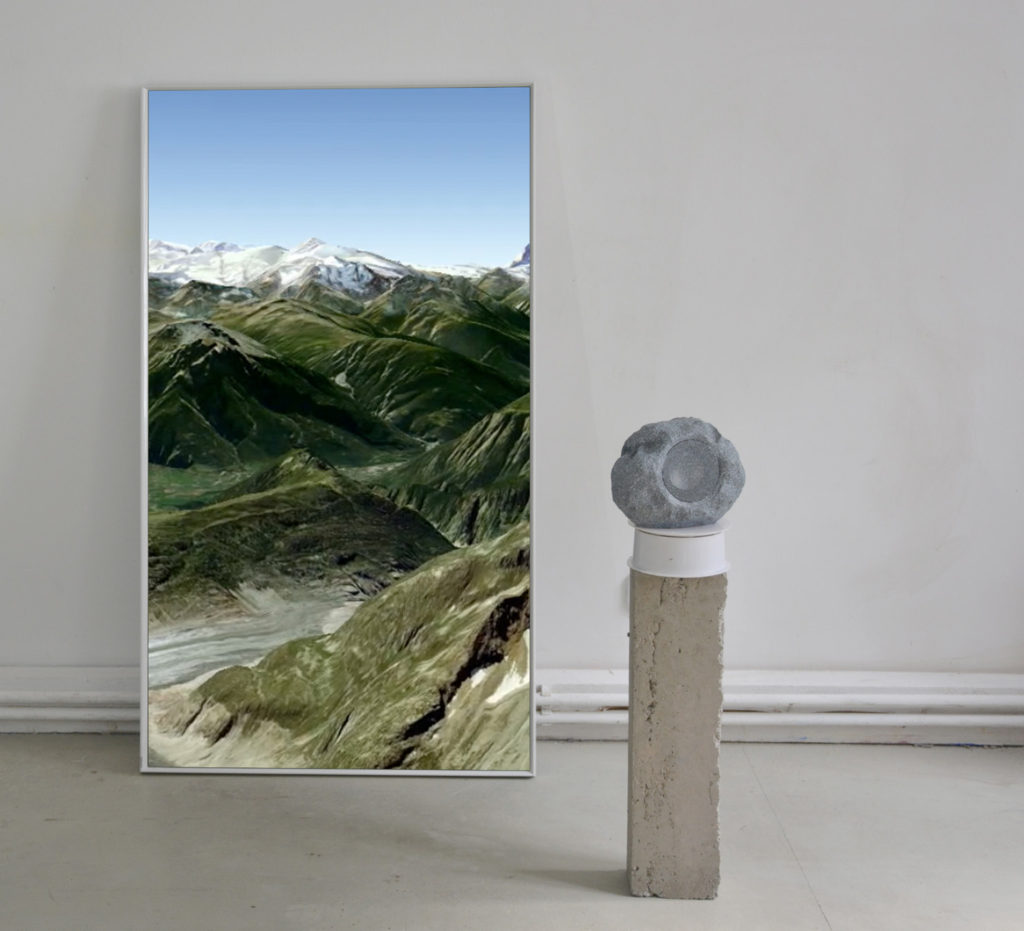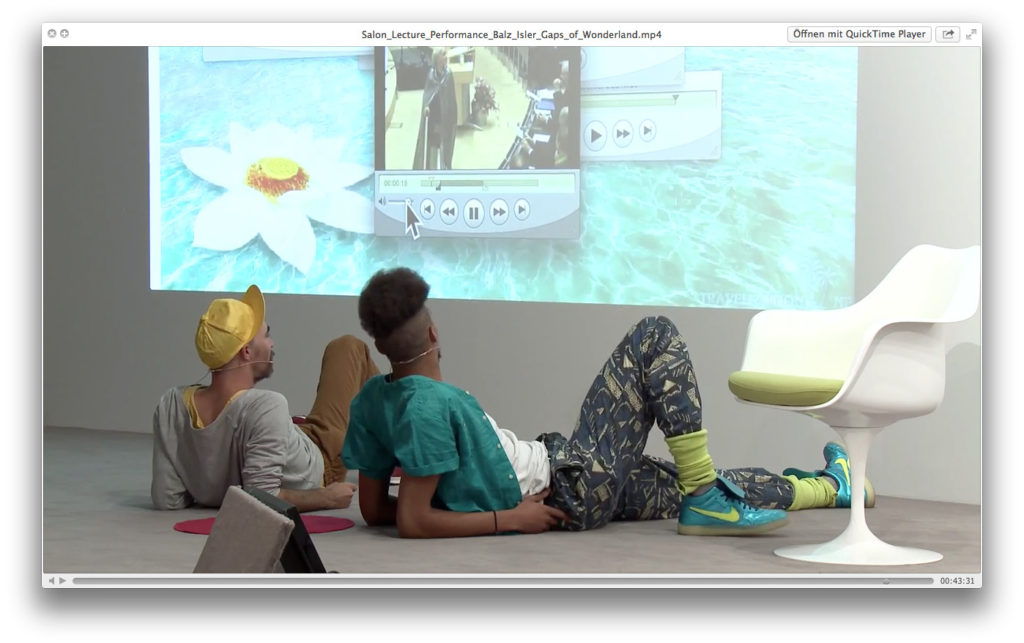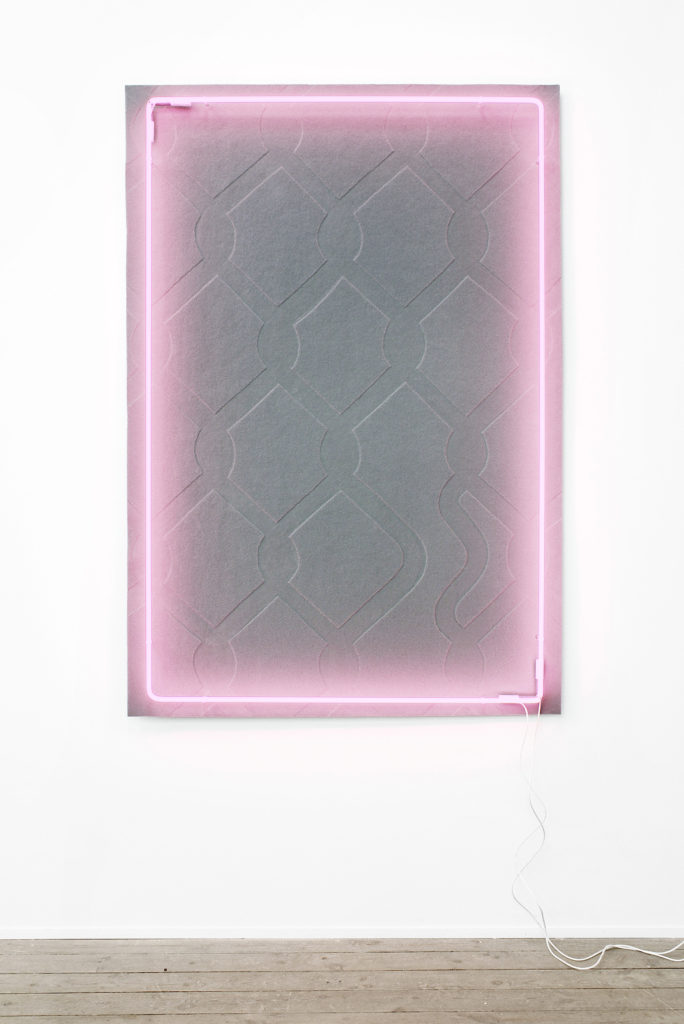Balz Isler’s work is an all-encompassing poetic interface. Stretching his practice through disciplines with ease, the Berlin-based artist works poetry, painting, sculpture into active sites of sound, video and performance. Isler’s work articulates modes of on and offline realities through his narratives and dry, humorous personas. He performs, with a projector and laptop in a quiet trance, moving images and sounds over a live-streamed output from his desktop onto his installations and constructions he has built up in a variety of gallery spaces.

Isler’s dulcet singing tones move softly over the projected interfaces he uses in his live performances as he concocts an improvised array of sound samples, melodies and spoken-word monologues. His practice acts as a quasi-articulation of the ‘We’ but not the national ‘we,’ or the clique ‘we,’ or the inconsistent revolutionary ‘We.’ But a ‘We,’ he says, he hears and observes from his daily life or a daily ritual. Speaking to me in his studio on the first days of spring in Berlin — and in anticipation of his upcoming contribution to the just in F. Kennedy-organised Forgotten Friends: a grey, or maybe purple Safari group show and “guided tour” in Copenhagen, March 30 to April 1 — Isler thoughtfully answers my questions. There’s a lighter on his desk, plus two Club Mate soda bottles, a chocolate croissant and a small black and white image of a woman jumping into a neutral landscape. A scalpel laid next to the female figure, Isler had freed her from her frame, carefully cutting her out. He demonstrates, she could easily be placed back inside it, or jump inside or out. This would be the first of many conversations to come, where we’d spend the next weeks, moving through emails and mother tongues — his being Swiss-German, and mine being English — meeting, at times, in the middle.
Having first seen him play at Les Urbaines festival last year in Lausanne, Isler seems to act as a channel almost in a pseudo-esoteric way but not for the dead, for the living channeling the digital and the archival of the present, past and future. The audience often gathers around Isler, as he is lounges over his computer, which hosts a hard drive manually gaffer-taped onto the casing — a motif of his practical humour and ability to hack with an ultimately relaxed output onto the “screened stage.” Isler’s fingers never leave the trackpad during his performances, flicking his eyes from the screen to the projector where he sets up jpegs and .mov files offering compositions or brutal moments of a singular file cancelling all the other files out. As a viewer, you understand you are being told a story, or that you are party to a performative lecture. But the way Isler lays out the images is more like a lucid dream. Glitched, fractured and recognisable. His use of platforms such as Youtube add another guise of the familiar; so familiar they become impersonal to all, adding a tinge of the uncanny from these digital citations. Isler is not an easy artist to put into a genre or a practice that he shifts from the arts, to theatre, to the web, to the club – this inability to place him is actually the very essence of why his transcendent production is so hauntingly hyper-physical to the viewer. Our conversation over following our initial in-person meeting, mirrors one of these performances. From IRL to URL, we traverse ideas of identification, the problems of genres and the learned apparatus of digital and material aesthetics.

** Where did your cross-disciplinary practice start?
Balz Isler: As a child I was subjected to hours and hours of self-made documentation, mostly from my father but also my grandfather. VHS was booming and my father had a penchant for the home-movies but what fascinated me was the way it was presented. The selected scenes, the music, the titling, the way we all sat round to watch — thinking about it now, we were very subjected to home-units of archival technology. My grandfather also performed rituals around slide-show presentations for us.
This modern technology enabled the everyday family to become some kind of celluloid fantasy — a narration. I obviously honed-in on this narrative and started to use it in my work, especially as a late teenager born into the internet era — it was a natural progression.But I do want to add, this has nothing to do with TV or celebrity culture, the TV had its own place and it was barely watched in our house — this was more theatre than film, so to speak.
** What role does sound play in the world of the digital archive?
BI: A very central and connecting role for me! When it becomes possible to transform the digital into the audible, and our own individual sound into music, it erupts as a non-confessional archive. This is a pure connection.

** This method of extracting from life, to present a life is something very common in your work.
BI: Yes, I have been pulling online footage, in a particular format of my pictorial concerts, for about six or seven years now. The amount is vast, just like my forefathers but obviously not as spatially vast — mine all sits on hard drives rather than in boxes and boxes of film. This is also an interesting move into the archive, as far as we can accumulate more than we can ever see, but I’m more interested in trying to pull the sensory from images — both moving and still.
Can you create a smell from watching something, or pull an inner need or desire that is resting in you from someone else’s home video or stream? I have always been interested in trying to take the moving image, or live image further — how can I improve on it, how can I be present in it. I guess that is my template for most of my performances. I insert gestures, like singing, staging and performing, into the images to make them live.
** When I saw your performance at Les Urbainies recently, I was struck by your ability to stretch and go beyond the ‘found image,’ or, as Hito Steyerl would say, the ‘poor image,’ transcending the viewer into a sort of on/offline poetry interface.
BI: Well, I have always seen myself as more of a ‘solution-ist’ than an activist. I’m constantly using motifs to direct the viewer, even if they are not explicit. I may want you to see a lighter but I may ‘never’ show you a lighter. The viewpoint of the audience is also soaked in content and aesthetic iterations.

** You mean, like culturally learned historical motifs of understanding?
BI: Well, in a way, yes. I mean, we spoke earlier about the way in which the archive has changed texture from film to pixels but what I notice, more and more, is the fact the very motions of people’s perception have not changed. We still look at life from three angles: the past, the present and the future. These sites of viewing have not changed, we are relational beings to our own existence. My works try to hint at other more collaged-modes of this existence. I try to strongly erect diversity in the performances, whilst also sitting amongst coexistence and acceptance. I give the audience what they like. They like it when I sing, for example, but I’m also slotting in other layers of political imagery and concepts.
** Is your work autobiographical in that way then, even though you use found resources?
BI: This is something I’m always troubled by. I mean, I think I am self-critical, so in this way the work is able to be emotionally read by a larger audience than just my immediate peers. But I do also get pigeon-holed a lot, as being a Swiss artist because of my sense of humor and wry distance on life — this is an odd conundrum. I was born in Switzerland but then I moved and studied in Hamburg, and have been living and working in Berlin for the last 10 years but I’m still Swiss to the art world. I’m not sure about this autobiographical part at all. Obviously I had to see it to create the thoughts that produce it but, in my mind, I am more the ‘We’ Zone rather than the ‘Me’ Zone. I am channeling all of us. We all feel different things, yes. but the conducting of that feeling en masse, capitalizes and creates a sense of cultural use. This use is what I am reacting to, or re-performing I guess.
** This idea of capitalizing on mass culture or being pigeon-holed makes me wonder how you feel about the genre ‘Art Bro?’ Or at least being dropped into this category?
BI: I identify with ‘art brut ’ tendencies, for sure, rather than ‘bro’; the availability and exploitation of the found image, the slick aesthetic, and the digital anthropology as content, for sure. But I’m not trying to keep the art brut element alive, I don’t want just to make work because we have learned how to read it. In a sense, we now know the language of art brut. My artistic being is really about being present and evolving with life, politics, time and space, and how I can serve up this knowledge of life and its physicality to an audience, but not for them.

** Do you mean you don’t produce for the audience like a ‘typical performer’?
BI: I don’t typically rehearse, for example. I have a few keys and motifs but I follow my mind, my movement. I’m not doing this for an audience. I often realize this after I have performed. I transcend into this wild space during these ‘live’ moments I have to activate the technology, yes, but that becomes the flow. I also know I can’t get into these spaces without the audience either. I have tried to rehearse, practice etcetera but it creates another kind of work. I guess, this also leads into the fact I’m kind of everywhere in the field; never really fitting into the arts, theatre or music scenes. I’m a system. I enact a system, a system we are all individually and collectively a part of, and I just frame it in a live performance for a matter of minutes, moments or hours.
** For you, what’s the physical essence of music?
BI: Hmm… Well, it’s an enormously physical entity but it’s equally a mythical and spiritual character. Music has a deeply cleansing affect on me, and I enjoy the fact that it is so immaterial in its residue. In this way, it has an almost unencumbered affect on me. Of course, music can be just as burdensome and almost trigger violence as any other material, but often it feels freer and more immediate. Through its ephemeral nature it radiates something solely independent, which makes it extremely enjoyable and interpersonal.**













